Megacolon

Description
Megacolon is a congenital or acquired hypertrophy of the entire colon or its individual parts.
The clinical picture consists of chronic constipation, abdominal distension, abdominal distension, fecal intoxication, temporary attacks of intestinal obstruction.
The clinical condition in proctology is referred to by the term Chagas disease, Hirschsprung disease, idiopathic megacolon, etc.
In the disease, there is an increase in the lumen, thickening of the walls, lengthening of part or the entire colon.
As a result of the pathological hypertrophy, inflammation and atrophy of the mucous membrane develops, peristalsis and the evacuation of the contents of the large intestine are disturbed.
In the disease, the changes are usually limited to the sigmoid colon as it expands and simultaneously lengthens.
What are the symptoms?
The course of the disease and the particularities in the clinical characteristics are directly related to the length of the affected part and the body’s compensatory capabilities.
When the clinical condition is congenital in the first days or months of life, independent feces are not formed, as a result of which flatulence develops, the circumference of the abdomen increases and a state of chronic fecal intoxication is reached.
Periodic vomiting is observed, the contents of which are mixed with bile liquid. Defecation occurs only after introducing a probe into the intestines or when performing a cleansing or siphon enema.
Feces are characterized by a putrid smell, content of mucus, blood, particles of undigested food. Children suffering from the disease lag behind in their physical development and acquire anemia.
Progressive chronic constipation and swollen colon cause the abdominal wall to thin and bend, forming the so-called “belly frog”. Through the anterior abdominal wall, it is possible to observe the peristalsis of the intestines due to their visible contour.
The expansion and swelling of the large intestine in the disease is accompanied by the high position of the dome of the diaphragm, thus reducing the possibility of the normal swelling of the chest during inhalation, which also affects the respiratory function.
As a result, the size and shape of the chest changes. Against this background, cyanosis, dyspnea, tachycardia develop, changes in the electrocardiogram are also registered, and conditions are created for relapsing pneumonia and bronchitis.
Frequent complications of the disease are dysbacteriosis and the development of acute liver failure.
In case of dysbacteriosis, secondary inflammation develops in the intestines and wounds appear on their mucous membranes, which manifests as paradoxical diarrhea.
The development of obstructive ileus is accompanied by uncontrollable vomiting and abdominal pain, and in very severe cases colon perforation and fecal peritonitis occur.
Strangulation intestinal obstruction develops when the intestines become tangled or knotted.
Treatment of megacolon
The therapeutic strategy is determined depending on the clinical course and form of the disease.
In the case of compensated and subcompensated flow by the body, as well as in the case of inorganic forms, a conservative approach is taken.
The therapy consists of a diet including foods with a high fiber content, enemas – cleansing or siphon, the appointment of probiotics to normalize the intestinal flora.
Preparations containing synthetic enzymes are also recommended; modulators of the motility in the large intestine, abdominal massages, conducting physiotherapy and electrostimulation of the rectum.
In case of Hirschsprung’s disease, an operation is required, during which a resection of the aganglionic zone and the dilated part of the large intestine is performed at around 2-3 years of age.
In the case of obstructive megacolon, emergency colostomy and preparation for radical surgical intervention are required.



